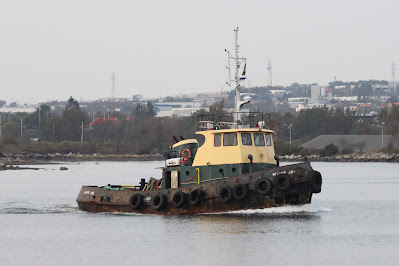When pilotage operations resumed early this morning (Friday, December 22) after the latest storm had passed and sea conditions moderated, there was a major backlog of shipping to accommodate. Most of these ships will have to take their turns in order of earliest scheduled arrival as there is a limit to the number of berths in the port. As of late afternoon there were still six ships hove to off Halifax waiting their turn.
Among the ships that did enter port was the Annie B, a first time caller on ZIM's CGX feeder service. It was due originally from New York on Wednesday December 20 but spent an uncomfortable two days slowly steaming back and forth or hove to well offshore away from the coastal swells.
The bright sunshine was deceptive as there was still a swell runnning in the harbour. With a very stiff northerly wind, and sub-zero temperatures, there was a lot of spray for the ship and the attendant tug Atlantic Larch.* (See also yesterday's Tugfax for some more splashy photos.)
The ship Annie B was hastily renamed in late June or early July 2023 by anonymous new owners Clement Shipping Ltd.
Built in 2003 by Hyundai Mipo, Ulsan the 28,596 gt, 39,383 dwt ship has a capacity of 2826 TEU including 554 reefers. Its original name was Cardonia (still visible in welded letters on the bow) but was renamed on delivery as CMA CGM Ukraine, a name it carried until 2006 when it became Cardonia again.
A report on social media says that the ship will unload 49 containers and load 1035 during its stay in Halifax, which even for a feeder service seems light. Seasonal variations and world events may be factors in loadings as the shipping world is in a state of flux these days.
___________________
* The Atlantic Larch, built by East Isle Shipyard in Georgetown, PE in 2000, is a 4,000 bhp tug with a 51 tonne bollard pull rating. It is based in Saint John, NB, but is designated as an "outside tug" available for coastal work and other assignments away from its home port. It arrived in Halifax to supplement the local tugs while Halifax Shipyard "launched" the latest Arctic Offshore Patrol Ship, AOPV 434 on December 9.
There has also been additional activity in the port with more wind turbine components arriving and the Atlantic Bear had a short spell at the Shelburne Shipyard for its ten year classification renewal survey. Halifax can keep up with demand with five active tugs, but six would be preferrable in winter and other busy times. Regular tugs in Halifax are Atlantic Oak, Atlantic Fir, Atlantic Bear, Atlantic Beaver, and Atlantic Willow. Since early December the tug Atlantic Elm, not normally a harbour tug, has also been in Halifax, attending barges used during the transfer of the wind turbine towers, and other miscellaneous chores such as ship docking in Sheet Harbour. It also stood by in Cape Breton while the bulk carrier Genco Endeavour effected repairs.
.








































.JPG)












